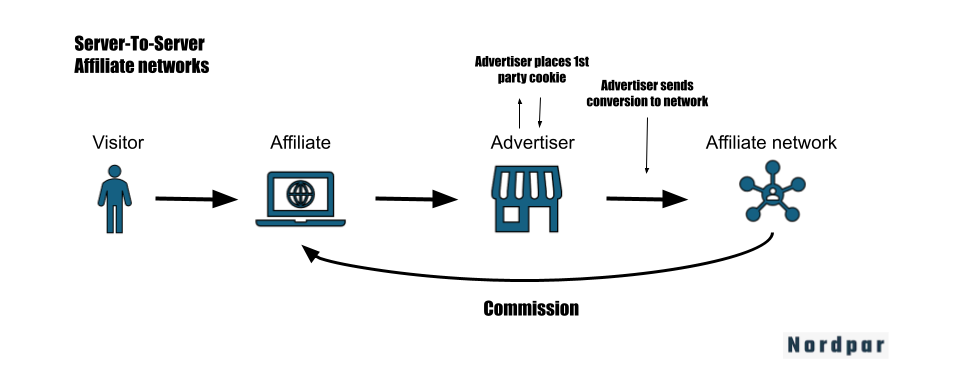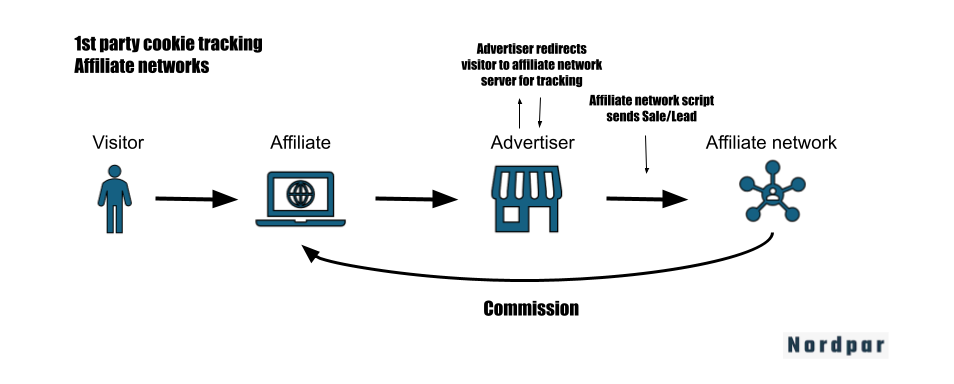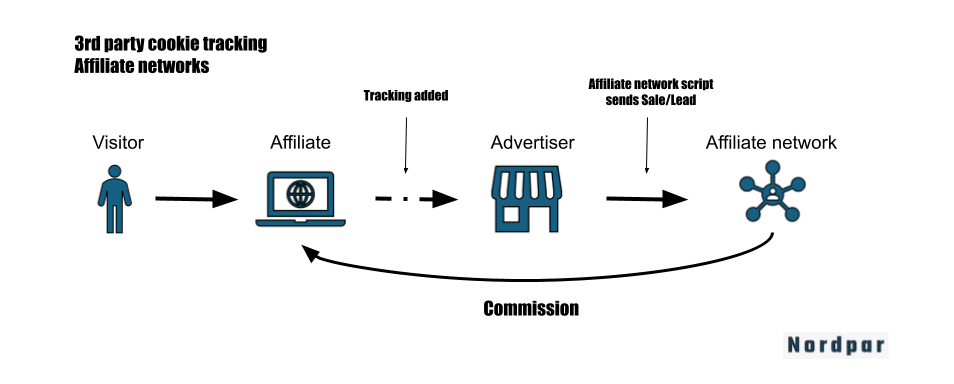Detailed advanced partnership management guide

Affiliate and partnership management has many layers and there’s endless ways to optimize your affiliate program, to standout from competition and build trusting relations.
This guide is for managers that have experience running an affiliate program and looking for additional ways to optimize.
In this article we’ll cover the most important topics and strategies, that we implement and use to increase the succes for advertisers.
Commission strategies
As a standard your affiliate program offers one commission, but if you haven’t already thought about grouping or adjusting the commission to match your situation, then this is a big opportunity to make your campaign more attractive.
Your situation could be that you want to offer certain affiliates higher commission if they reach X amount revenue or sales.
Below we will go through what is possible and the give our take on the best strategies.
Before we dive into it, then you should already know what your maximum CPA/ROAS target is, because going into optimizing your offered commission, most important is that you know at what level you will still be profitable.
For the sake of simplicity in below examples we take that your maximum CPA offered is 10% of a sale, which translates to a 10x ROAS. Your actual maximum CPA is determined by your ROAS targets for the channel, the competition in the industry and your goals.
Commission tiers
The easiest and most common is that you create 2-3 tiers for your program, which could be 6%, 8% and 10%. The default being the 6% and using 8% and 10% to place publishers manually in or set certain rules in your affiliate program, to move them higher.
If your program is manageable then we advise moving them manually. Reasons to move a publisher, could be:
- They work well and you want to incentivize more business
- You agreed an increased promotion for a time period
- A publisher category you wish to work more with
Among others…
While moving manually only works to a certain size of the affiliate program, there are other automatic segmentations in order to incentivize your long tail of affiliates without being the bottle neck for growth which we will cover below.
Ladder commission strategy
Stepping into the automatic setups, a ladder system is one of the most common. Our experience is that the model you set up at all points needs to be transparent, goals are reachable and attractive.
Let’s use the same 3 step ladder of 6%, 8%, and 10%. Using the ladder strategy to incentivize with a revenue or transaction amount is set.
An example could be:
- Default – 6% commission
- More than 10 sales last 30 days – 8% commission
- More than 20 sales last 30 days – 10% commission
Or
- Default – 6% commission
- More than €5.000 revenue last 30 days – 8% commission
- More than €10.000 revenue last 30 days – 10% commission
There are pros and cons by using the ladder model, but the main advantage is that if you have limited time managing your program but still want it to be attractive, then this model can automate incentivizing your publishers doing more.
We do recommend always recommend that on top of a ladder model, your key partnerships needs to be nurtured directly and maybe needs to be raised in commission regardless of their achievement, if you believe they give brand or business value in other ways like co-branding etc.
New vs old customers strategy
This strategy is used by advertisers that usually run very low margins and wants to incentivize attracting new customers vs. old/current customers.
The challenge with affiliate marketing compared to other marketing channels is that the affiliates generally have very little control of knowing whether they target new or current customers of an advertiser.
Mainly this is a cost saving strategy from an advertiser point of view. You can also focus more on top funnel traffic vs. low funnel traffic and this should also make you reach the same goal of attracting new customers vs. retaining old.
Our goal is always to create the most attractive model for the advertiser that still is transparent and working well for publishers, but this model we generally do not recommend.
Publisher category split strategy
This strategy we definitely recommend implementing, once you’ve defined which publisher category types works well for your business.
The goal is to save cost on publishers that would promote your program regardless and give maximum commission to the types that create value and you want to do more business with.
In an ideal world, then let’s say you received a goal by your manager not to exceed the 10x ROAS, but implementing this you have a 14x ROAS, that extra you receive can then be re-invested to top funnel publishers either via additional commission increase or in the form of buying extra placements with a fixed budget.
A good way to segment, is building the commission model based on the traffic funnel. So that you pay most to those in the top and least for those in the bottom.
For simplicity let’s take the 3 tiers for this model as well which could look like:
- Top funnel – 10% commission – Content sites, Facebook ads, Influencers, Deal sites, Display/media buy, Native ads
- Middle funnel – 8% commission – Price comparison, Google ads, CSS/Google shopping, content comparison, community sites
- Low funnel – 6% commission – Voucher, cashback, retargeting, on-site, review sites
Based on your industry and business goals, then of course the different types can move funnel levels, but in general this is a good starting point.
Depending also on the maturity and size of your affiliate program, then it makes sense only to consider few for the specific funnel levels. In this example the standpoint is a very mature and large program so that all types needs to be considered.
Product category split strategy
If you as an advertiser has many products in your webshop or work with very different margins for product categories. Then this strategy is a must, because you should then adjust what you offer your affiliates based on what is being bought.
Especially electronic hardware companies use this strategy, to give lower commission on certain products and higher commission for others to incentivize what affiliates promote and save costs.
An example could be:
- Laptops, TV and consoles – 6% commission
- Keyboards, mouse and headphones – 8% commission
- Converters, chargers and computer screens – 10% commission
It is very important that not too many tiers are made and the labelling is transparent as it otherwise will be too complicated for publishers to know what they receive when promoting what they intend to.
It also requires usually some technical understanding from the advertiser to implement and categorize this correctly. This we help our advertisers with to achieve.
The perfect commission strategy
Now to the perfect strategy!
Disclaimer before diving in, the perfect strategy handpicks parts of above strategies and works only works well when your affiliate program is of a certain size and maturity.
The reality and bottom line implementing the strategies is that you reach your goals, but keep it attractive and transparent for your publishers as well and then stick to what works.
There’s nothing more damaging to a program than ever changing terms and conditions. So always consider any consequences your planned changes might have and does it actually achieve what you want without losing your affiliates along the way.
Tailoring is key!
The perfect model is tailored to each business, but if we were to give our take on an ideal commission model, where all affiliate types are accepted and our ROAS target is 10x. We would have 3 tiers, two of which are visible and a third preserved for top performers. In practice giving 3% and 8% which visible and the 10% not visible.
One key aspect of affiliate marketing is negotiation, which we will also cover in-depth later, and you would never disclose your top segment right away, if you want to have those top publishers promote with you, because they would expect above what everyone else receives, why the last 10% commission is hidden.
In the tiers we would automate that top and mid funnel affiliates are placed in the 8% segment and low funnel in the 3%.
That way low funnel will still be on the program, but we incentivize and focus on top and mid funnel that generate new sales and adding value to your brand.
The 80/20 rule
The goal once implemented is identifying your top performers as the 80/20 rule or the Pareto principle, also applies to the affiliate business, which is that 20% of your publishers will generate 80% of your revenue.
Identify those 20%, negotiate the best possible plan for the coming future of the collaboration and place them in that 10% commission tier.
With this strategy you should be far from the original ROAS target of 10x and let’s say the affiliate channel is now generating you €100.000 in revenue and the cost is €8.000 meaning you have a 12,5x ROAS.
Re-invest that €2.000 in your top performers and this way you maximize the outcome of your affiliate program.
Not all advertisers use a fixed budget, but if they did, that would unlock certain large opportunities with your best publishers that no commission can buy and ensure an even closer collaboration with your top performers.
On top of the tiering, we would have you consider also implementing a product category split, so that you can offer more in cases where your profitmargin on products is larger.
These are our recommendations for a perfect model and further modification would be very industry or business specific.
The key takeaway should be to always keep your program attractive to your affiliates and if you have a long standing program, talk with them to receive feedback on their take on what can improve.
Advanced tracking
The tracking of affiliate marketing is ever changing and each network has their own take on how the best approach is. Here you get an overview on the most common solutions and why you should pick them. We assist companies with affiliate marketing tracking and get in touch if you still have questions to optimizing your tracking.
Server-To-Server
This is the future proof tracking method as it relies less on the network and more on your technical setup. In most cases it requires in-house developers or a bureau like Nordpar.com that can advise and implement a correct solution.
The upside is that you are in full control of how people are tagged and when to send information to the affiliate network. Also this is future proof since you are tagging the visitor which (for now) is the correct way to go.
The downside is that it does require some technical skills and if something breaks you need to fix it, as the networks probably have limited knowledge about the customization needed to make it happen.

1st party tracking
This is called many things by affiliate networks and is usually implemented via a subdomain redirect calling or redirecting the user to the network server in order to place the adequate tracking.
This is by default today the most common way advertisers are integrated with networks and is easy for both parties to implement and maintain.

3rd party tracking
3rd party tracking is the old way and if you spot a link that mentions the affiliate network directly, then that is usually a 3rd party tracking link, which in todays time and age is being outphased.
Haven’t you already shifted to Server-to-server or 1st party tracking, then now is the time before your tracking becomes unreliable due to the many restrictions by browsers limiting or deleting 3rd party tracking data.

Optimize payout cycle
One area that is often overlooked by advertisers, but is the most important for publishers, is when are they getting paid for their work and how quick is the process from sale to payout.
Our experience is that even if you pay more than a competitor commission, it is still hard to move them away from an advertiser that has a short payment cycle and always pays on time.
This is why it is very important for you as an advertiser to make this cycle as short as possible.
Best case would be to accept all sales as is and pre-pay your network, so that they can withdraw the amount on due-date and that will give the shortest payment cycle.
In practice there are of course many factors and risks that this may entail. But with a well managed program run by specialists, this is possible without having to worry of the risks it might entail that fraud publishers or publishers not fulfilling the terms and conditions of the program join and promote as they would have been removed or not accepted.
If you have a current program consider the following:
- How can we shorten the time we evaluate sales?
- How can we pay invoices as soon as possible?
Also do consider any pre-payment solution that your network offers and accepting all sales. From a publisher point of view, this is a big plus when applying to programs.
To counter any cancellations or returns, rather look at adjusting your commission to accommodate that, because that is also a huge plus for well established publishers.
Data and dashboards
To make most out of your affiliate collaborations, keeping overview on opportunities and making sure that drops in performance is noticed is very important to maintain steady growth.
Nordpar is on a mission to provide tools to affiliater marketers and uniquely offer an affiliate marketing dashboard for advertisers to gather data from all campaigns and networks in a unified overview together with the ability to download transaction reports and daily check in on performance.
Negotiation unlocks opportunities
Negotiation is key working with affiliate marketing, because unlike other marketing channels where you just have to manage a system, then each affiliate recruited can benefit from having a direct communication with you, the advertiser.
This is why that when setting up your campaign and commission, think about what the elements could be that brings value to a partnership. One thing is commission and read the section about my suggested strategies on how to make sure you can leverage a tiering model.
Beyond that then value that could be negotiated into a collaboration could be custom reports on bestsellers and what sells well. By updating your key affiliates with this information which is not standard can bring value to a collaboration and the affiliate would save time finding what to promote.
It could be custom material, like tailored banners, product feeds with specific deals or exclusive discounts or codes.
These are all things that should bring extra value to specific collaborations with the goal of an affiliate seeing more value in promoting you, rather than competitors.
On top of what you as standard offer, then get an overview on these value adding elements, which you can use to win over or optimize current relations.
Affiliate recruitment

The Google search
The classic way is to simply do research on Google to find potential affiliates to work with. Easiest and probably also the source to finding most new opportunities.
Depending on what type of affiliates you are searching for, then that determines the query. In general I would search for affiliates two ways.
Query search
This search you are mainly looking for content, comparison, blogs and other sites which visitors visit in the search for inspiration or confirmation on what to buy. Simply put your self in the spot of the searcher and lets say you’re a bike shop looking for affiliates, finding affiliates would be with the help of the following queries:
- Best bikes
- Bike review
- Bike comparison
- Top 5 bikes comparison
Or in the travel industry it could look like
- Inspiration traveling to Barcelona
- Barcelona travel tips
- What to visit when in Barcelona
- What do to in Barcelona
All these searches will have a good bunch of affiliate sites present, which you should reach out to if not already working.
You get the idea of what to search and build your method to find new opportunities.
Detailed search
Are you in search for a specific category, you could also search for it directly, like:
- Cashback sites in UK
- Deal sites in UK
- Comparison sites in UK
- Content sites in UK
Then you would end up with lists and probably affiliates sites listing the individual sites, which you can directly pick from, to make sure you work with at least the largest sites in each country your affiliate program is active in.
Snatch affiliates from competitors
There’s a couple of ways finding affiliates promoting your competitors, the easiest is probably doing the Google search and like any sales process, find their weaknesses and leverage them when pitching to an affiliate, why they should consider promoting you instead.
The other main way to do this on scale, is finding the competitor affiliate links and identify parameters that are consistent, this could be a campaign id or anything that appears to be present just for their links. Then either Google search that specific information or use SEO tools like Ahref or similar, which on a larger scale can find specific links linking to a site and voilà you have a list of affiliates that might be very relevant to your brand.
Affiliate network tools
One of the main services offered by networks, is enabling you with the right affiliates. So put them on the task on what to look for and recruit to the affiliate program.
It should be in the networks interest adding more partners to the program, so make them work for it alongside you recruiting publishers directly as well.
Onboarding
Onboarding publishers properly is tricky and requires a lot of steps and material, but when done right, you should see the rate of which new publishers become click active increases.
Go through the steps of which an affiliate needs to take in order to sign-up to your affiliate program and start promoting.
How can this process be smoothened?
Typically a process looks like this, in the case that the affiliate is completely new to both the affiliate network and your campaign.
- Sign-up to affiliate network
- Submit and approval of media
- Sign-up and approval up to advertiser affiliate programmes
- Generate deeplinks, get banners and create product feed
- Start promoting!
There are factors of which you do not control in the process of signing up to the network, but it is good to be aware or introduced by the network to how your affiliates sign-up, what they need to do and how much time this process is estimated to take.
Big plus if you have an external publishers to the network your work with that you can forward them to your contact at the affiliate network, so that they can assist in case of questions and make sure they are onboarded right away.
Make a proper introduction!
New affiliates signing-up to your campaign is a new potential source of revenue, why it is very important it starts well!
Make a great deal out of having all material available (banner, product feed, recommendations etc.) and a proper campaign description as this will be the teaser working with you.
So do not hesitate including key data on what they can expect working with you, which could be conversion rate, EPC, commission details, bestsellers.
Also make sure that you are reachable and include contact details in case they have any questions.
Affiliates starting to collaborate with you invest time and money without receiving anything at first, so treat them well, once they’ve shown interest and committed to trying working with you.
Treat affiliates like clients
By that I mean that once they’ve signed up, send them an email right away that either is tailored or premade sent automatically welcoming them and informing about the most important details on how to get started.
Also any incentives, like increased commission, specific promotions, bestsellers or landingpages they should be aware is worth gold for them to start earning their first commission with you.
Keeping a good relation is key to being succesful with affiliate marketing. Investing time and knowledge is what makes them stay and share with you their opportunities for growth with you.
Still have questions for advanced partnership management?
We hope you liked our guide and it had the input you looked for! If you’re still in doubt what you can optimize, we’ve also made you a test so that you get our feedback on what can be improved in your affiliate marketing program. Check it out on the link below:
Advertiser affiliate marketing test
Our goal is to improve the affiliate marketing industry with tools and expertise. If you have questions on anything needing solved, give us a call or email.
How can we help?
If you have questions
call us or send us an email
We’re here to help!

(+45) 49 40 41 49

info@nordpar.com
